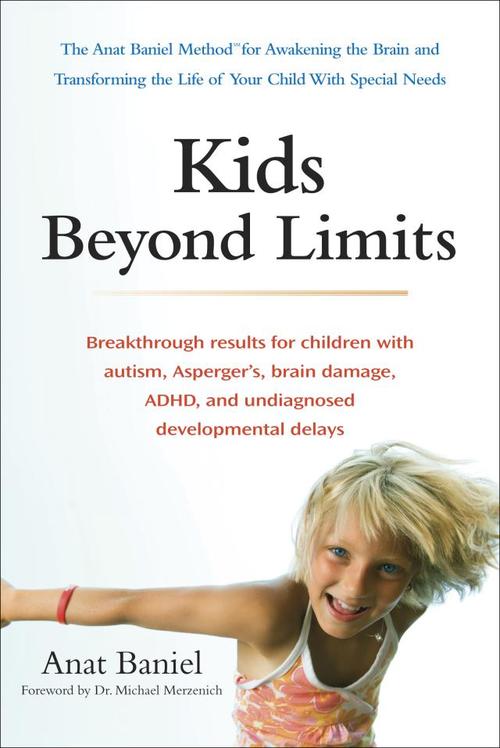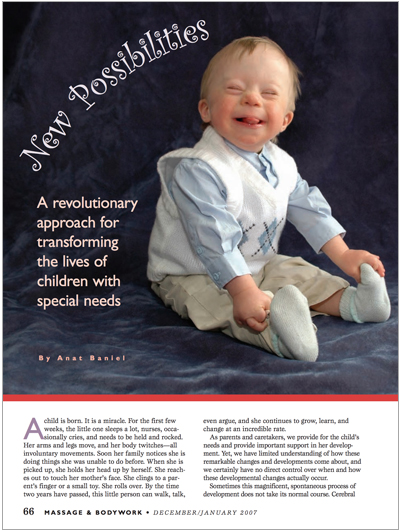
Is your infant recovering from a traumatic birth injury?
Has your child been diagnosed with cerebral palsy?
Do you have a child with developmental delays or a genetic syndrome?
Does your child have an attention or sensory disorder?
Would you like to maximize your child's ability to learn?
“The greatest potential for transformation, though often difficult to grasp, is not in trying to make children do what they can’t, but in finding ways to help each child’s brain differentiate and spontaneously discover how to go beyond his or her limitations.”
Learning beyond limits for children
Learning is an exploratory process that's necessary for brain development. In order to make sense of ourselves in our world we all need to learn to differentiate, integrate and form well-organized patterns of movement, thought, feeling and emotion.
The exact same neuroplastic learning principles—The Nine Essentials—that can help adults move without pain, highly skilled athletes reach the next level of performance, stroke survivors regain function—can be especially transformative for children who have learning challenges and special needs.
The focus of Anat Baniel Method® NeuroMovement® lessons is on potential and possibility. Rather than forcing a child into a developmental milestone they are not ready to do yet—which only grooves in their limitation and sense of failure—ABMN lessons meet the child where they are in their development, and help them build skills from there.
ABMN lessons wake up the child's brain to new possibilities of movement and action—helping them differentiate, map and form new neural connections—leading to spontaneous, often remarkable breakthroughs in movement, thinking, emotional self-regulation and connection with others.
Positive changes can include But are not limited to:
Greater awareness of self and others
Improved mobility, strength, balance and coordination
Reduced spasticity and chronic muscular contractions
Effortless, more skillful, pleasurable movement
Better breathing, anxiety relief, sounder sleep
Calmer, improved mood
More focused attention and increased eye contact
Improved ability to match intentions to actions
Clearer communication
ABMN is not diagnosis or injury-specific. Even if I work with two children who are the same age and have the same diagnosis—the way each child moves and organizes themselves for action is totally unique to them—because each child's acquired life experience of movement, development, response to their diagnosis or injury, and their environment is so unique.
Each lesson is truly tailored to the child as they are organized in that moment—so it is not one-size-fits-all. That said, ABMN lessons can help children who have the following conditions:
Developmental delays
Cerebral palsy
Hypertonia and Hypotonia
Hypermobile joints
Stiffness and rigidity
Brain damage
Stroke
Anxiety
Selective mutism
ADD/ADH
Autism spectrum
Sensory processing issues
Traumatic birth injury
Premature birth
Torticollis
Brachial plexus injury
Post-surgery or injury limitations
Balance & coordination issues
Angelman's syndrome
Genetic disorders
Birth defects
Neuromuscular disorders
Scoliosis
TMJ
What a lesson is like
From the very start of the lesson I connect with your child to find out what interests them and engages their curiosity, attention and learning switch.
I observe what movements your child is already able to do easily, and highlight distinctions and variations around that movement.
While I assist your child in guided, gentle, slow movements, I amplify her awareness of herself in space as she moves. Throughout the lesson I use movement with attention, gentle touch, subtlety, imagination, lots of variations and The Nine Essentials to feed your child's brain with a rich source of opportunities to perceive differences.
I will not force your child into a developmental milestone they are not ready to do yet—which only grooves in their limitation. For example, when a child is unable to come up to sitting, crawl or stand up on his own, I will avoid trying to have him be in this position until he has figured out how to do it himself, with no help or with minimal help.
If there is a small toy or a book your child likes, you can bring it to the lesson. Often children get hungry during a lesson, so having a snack on hand is a good idea. After a lesson, I recommend that the child has at least 2 hours to rest and eat.
Each lesson is unique and tailored to your child. Subsequent lessons build on the learning from the previous lesson. Lessons are no more than 30 minutes for children so as not to exhaust them.
I strongly suggest reading Anat Baniel's Kids Beyond Limits before you bring your child in for an intensive series of lessons. It can be a great resource to you and your child's caregivers. Each chapter is dedicated to one of The Nine Essentials with concrete examples of how to use them when relating to your child.
Scheduling an intensive series of lessons
Like learning any new language, immersion is more effective than a single lesson once a week. For that reason, I work in an immersive series of lessons called an intensive.
An intensive is 10 lessons scheduled within a 5-14 day time period: either 10 lessons concentrated within 5 consecutive days (2 lessons a day, with at least two hours in between lessons for resting and eating) or a single lesson a day for 5 consecutive days the first week, then two days off, then the following week a single lesson a day for 5 consecutive days. The lessons build upon one another and the immersion is what helps the newly learned patterns take hold and be adopted.
Depending on the needs of the child, I may recommend coming in for additional intensives, with periods of rest in between.
During an intensive series, after the lessons, it's important to keep other activities low-key so the child has an opportunity to sleep, rest and integrate.
If your child is in other therapies such as OT, ST or PT, I recommend for the time-period that they are getting an intensive series of ABMN lessons and for the week or two after to temporarily suspend the other therapies. Having the child in multiple therapeutic modalities all at once can be exhausting and confusing for the child, especially if the approaches are very different. The other reason is so we can see what it is working and making a difference for the child more clearly if they are only experiencing one intervention at a time.
Reach out
If you are interested in a free, 20-minute phone consultation regarding lessons for your child, and would like to be on my mailing list, please fill out the contact form below. I look forward to talking with you and will get in touch as soon as I can.
Recommended reading
Above, this video features the story of Nash, who had global brain damage at birth. Allie & Wyatt, his parents, share his journey of development. They saw significant changes in Nash when he started getting Anat Baniel Method (ABM) NeuroMovement lessons. Nash has progressed so far and he started walking before his 3rd birthday!
“I think the Anat Baniel Method and Kids Beyond Limits has a great contribution to make to our collective practical efforts to make the best lives possible for children with autism—and other neurodevelopmental disabilities.”
Above, Carla Oslwald Reed, ABMN Practitioner/Trainer and Pediatric PT, explains some differences between ABMN and Physical Therapy.
Watch above video of Anat Baniel working with a child with brachial plexus injury.
“He does not speak but he feels deeply. He always wants to come see you and the other day when he was crying and upset, when he calmed down a bit he said, “I want to see Paige.” I can see when he comes to see you he is very present and engaged and receiving the information and lesson. I know he does not say anything but I just wanted you to know this.
From reading Anat’s book and seeing you work so carefully and slowly, I am getting a better picture of how compassion/softness is so powerful and so strong and can do what force or hardness can not. I am very touched by your effort and Danial’s connection to the work you do with him.”








